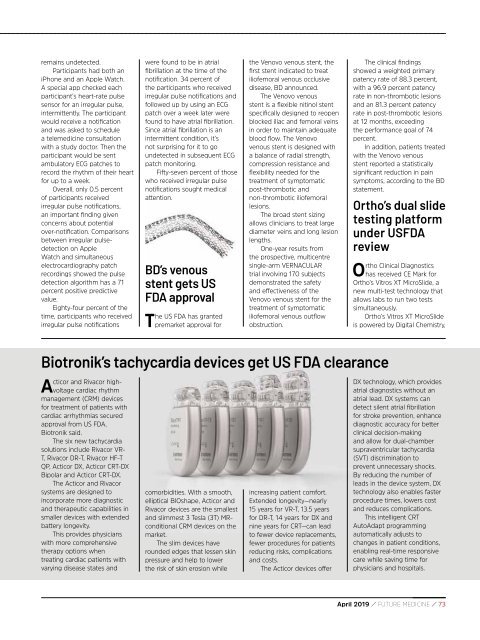Create successful ePaper yourself
Turn your PDF publications into a flip-book with our unique Google optimized e-Paper software.
emains undetected.<br />
Participants had both an<br />
iPhone and an Apple Watch.<br />
A special app checked each<br />
participant’s heart-rate pulse<br />
sensor for an irregular pulse,<br />
intermittently. The participant<br />
would receive a notification<br />
and was asked to schedule<br />
a telemedicine consultation<br />
with a study doctor. Then the<br />
participant would be sent<br />
ambulatory ECG patches to<br />
record the rhythm of their heart<br />
for up to a week.<br />
Overall, only 0.5 percent<br />
of participants received<br />
irregular pulse notifications,<br />
an important finding given<br />
concerns about potential<br />
over-notification. Comparisons<br />
between irregular pulsedetection<br />
on Apple<br />
Watch and simultaneous<br />
electrocardiography patch<br />
recordings showed the pulse<br />
detection algorithm has a 71<br />
percent positive predictive<br />
value.<br />
Eighty-four percent of the<br />
time, participants who received<br />
irregular pulse notifications<br />
were found to be in atrial<br />
fibrillation at the time of the<br />
notification. 34 percent of<br />
the participants who received<br />
irregular pulse notifications and<br />
followed up by using an ECG<br />
patch over a week later were<br />
found to have atrial fibrillation.<br />
Since atrial fibrillation is an<br />
intermittent condition, it’s<br />
not surprising for it to go<br />
undetected in subsequent ECG<br />
patch monitoring.<br />
Fifty-seven percent of those<br />
who received irregular pulse<br />
notifications sought medical<br />
attention.<br />
BD’s venous<br />
stent gets US<br />
FDA approval<br />
The US FDA has granted<br />
premarket approval for<br />
the Venovo venous stent, the<br />
first stent indicated to treat<br />
iliofemoral venous occlusive<br />
disease, BD announced.<br />
The Venovo venous<br />
stent is a flexible nitinol stent<br />
specifically designed to reopen<br />
blocked iliac and femoral veins<br />
in order to maintain adequate<br />
blood flow. The Venovo<br />
venous stent is designed with<br />
a balance of radial strength,<br />
compression resistance and<br />
flexibility needed for the<br />
treatment of symptomatic<br />
post-thrombotic and<br />
non-thrombotic iliofemoral<br />
lesions.<br />
The broad stent sizing<br />
allows clinicians to treat large<br />
diameter veins and long lesion<br />
lengths.<br />
One-year results from<br />
the prospective, multicentre<br />
single-arm VERNACULAR<br />
trial involving 170 subjects<br />
demonstrated the safety<br />
and effectiveness of the<br />
Venovo venous stent for the<br />
treatment of symptomatic<br />
iliofemoral venous outflow<br />
obstruction.<br />
The clinical findings<br />
showed a weighted primary<br />
patency rate of 88.3 percent,<br />
with a 96.9 percent patency<br />
rate in non-thrombotic lesions<br />
and an 81.3 percent patency<br />
rate in post-thrombotic lesions<br />
at 12 months, exceeding<br />
the performance goal of 74<br />
percent.<br />
In addition, patients treated<br />
with the Venovo venous<br />
stent reported a statistically<br />
significant reduction in pain<br />
symptoms, according to the BD<br />
statement.<br />
Ortho’s dual slide<br />
testing platform<br />
under USFDA<br />
review<br />
O<br />
rtho Clinical Diagnostics<br />
has received CE Mark for<br />
Ortho’s Vitros XT MicroSlide, a<br />
new multi-test technology that<br />
allows labs to run two tests<br />
simultaneously.<br />
Ortho’s Vitros XT MicroSlide<br />
is powered by Digital Chemistry,<br />
Biotronik’s tachycardia devices get US FDA clearance<br />
Acticor and Rivacor highvoltage<br />
cardiac rhythm<br />
management (CRM) devices<br />
for treatment of patients with<br />
cardiac arrhythmias secured<br />
approval from US FDA,<br />
Biotronik said.<br />
The six new tachycardia<br />
solutions include Rivacor VR-<br />
T, Rivacor DR-T, Rivacor HF-T<br />
QP, Acticor DX, Acticor CRT-DX<br />
Bipolar and Acticor CRT-DX.<br />
The Acticor and Rivacor<br />
systems are designed to<br />
incorporate more diagnostic<br />
and therapeutic capabilities in<br />
smaller devices with extended<br />
battery longevity.<br />
This provides physicians<br />
with more comprehensive<br />
therapy options when<br />
treating cardiac patients with<br />
varying disease states and<br />
comorbidities. With a smooth,<br />
elliptical BIOshape, Acticor and<br />
Rivacor devices are the smallest<br />
and slimmest 3 Tesla (3T) MRconditional<br />
CRM devices on the<br />
market.<br />
The slim devices have<br />
rounded edges that lessen skin<br />
pressure and help to lower<br />
the risk of skin erosion while<br />
increasing patient comfort.<br />
Extended longevity—nearly<br />
15 years for VR-T, 13.5 years<br />
for DR-T, 14 years for DX and<br />
nine years for CRT—can lead<br />
to fewer device replacements,<br />
fewer procedures for patients<br />
reducing risks, complications<br />
and costs.<br />
The Acticor devices offer<br />
DX technology, which provides<br />
atrial diagnostics without an<br />
atrial lead. DX systems can<br />
detect silent atrial fibrillation<br />
for stroke prevention, enhance<br />
diagnostic accuracy for better<br />
clinical decision-making<br />
and allow for dual-chamber<br />
supraventricular tachycardia<br />
(SVT) discrimination to<br />
prevent unnecessary shocks.<br />
By reducing the number of<br />
leads in the device system, DX<br />
technology also enables faster<br />
procedure times, lowers cost<br />
and reduces complications.<br />
This intelligent CRT<br />
AutoAdapt programming<br />
automatically adjusts to<br />
changes in patient conditions,<br />
enabling real-time responsive<br />
care while saving time for<br />
physicians and hospitals.<br />
<strong>April</strong> <strong>2019</strong> / FUTURE MEDICINE / 73


















